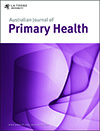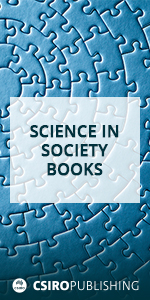Australian Journal of Primary Health
Volume 28
Number 6 2022
In September 2015, the State Council of China issued guidelines on building a hierarchical medical system, stating that the first visit rate to primary healthcare facilities should be increased to 70% for all medical facilities by 2017. This meta-analysis has estimated the willingness of the first visit to primary healthcare services in China after the year 2015 and identified its determinants. The Government should develop strategies to facilitate the implementation of the policy.
A move away from reactive, episodic models of health care delivery towards patient-focussed integrated care is required to meet the changing demands of an aging population. This forum article provides a reflection on the current state of integration for older people with complex needs through the lens of a local community facing model: OPEN ARCH. The OPEN ARCH experience furthers the evidence for ground-up approaches of integrated care that can meet the increasing demand and complexity of older people’s needs.
Over recent decades, Australia has become more unequal in terms of income, wealth, employment, and health. We analysed publicly available Australian data and found that the social gradient in health, income, wealth and labour force participation have all steepened. This makes calls for comprehensive primary health care even more urgent as one strategy to address underlying structural factors driving these worsening inequities.
‘Community health’ is an important element of Australian health systems and recognised as such in national policy. Interviews with 13 key informants in roles with responsibility for primary and community health services from health departments in Australian states/ territories found little uniformity in the way community health was described. Inconsistencies in the use of the term ‘community health’ and the complexity of the multi-jurisdictional context need to be acknowledged when considering the design and implementation of national health system programs and reforms.
Reaching pockets of under-immunised children requires tailored strategies for addressing local barriers. The World Health Organization developed the Tailoring Immunization Programmes guide to assist health services to identify areas of low coverage, gain understandings of barriers to vaccine uptake and develop tailored strategies. An economic costing of a Guide to Tailoring Immunization Programmes program serving marginalised families in the Maitland area of NSW was undertaken.
Variance in cardiovascular risk and disparities in care have been documented for women; however, the knowledge about gaps in care is less explored for sub-populations, such as Indigenous populations. This study explores the health profile and receipt of preventive risk assessment and management in primary health services for Aboriginal and Torres Strait Islander women compared with men, finding women and men alike experience gaps in the provision of care to meet identified health needs.
This study explores the management of chronic hepatitis B in six South Australian Aboriginal community controlled health services. This study has found clients received incomplete testing across the initial assessment, chronic hepatitis B monitoring and hepatocellular carcinoma screening. Through providing evidence of significant associations between having a recall set and GP management plans with increased uptake of disease monitoring, this study has highlighted areas for improvement in clinical management.
This research investigated how mothers with chronic hepatitis B understand and experience interventions for the prevention of mother-to-child transmission of chronic hepatitis B in Victoria, Australia. It provides knowledge and insights in healthcare delivery gaps for pregnant women with hepatitis B and their infants.
The widespread use of telehealth services for rural and remote communities might risk a shift away from the traditional model of informed person-centred care to a technology-mediated health transaction. Replacing face-to-face interactions with telehealth services has the potential of reducing trust, continuity of care, and effectiveness of health services. Telehealth must be used to assist local clinicians in providing the best possible care to rural and remote patients within the integrated service delivery model and across diverse rural contexts in Australia.
COVID-19 has influenced an increase in telehealth use in Australia. In this paper, we investigated the level of patient satisfaction for GP consults with telehealth services for the paediatric population. To our knowledge, this has not previously been reported on. Our results show that patients reported a high level of satisfaction with GP telehealth consultations for paediatric patients, and with limited barriers there is significant scope for the more widespread use and support of these services.
General practice is crucial to Australia’s national COVID-19 vaccine rollout and routine immunisation program. However, perceived poor communication and rapid policy changes by government and peak bodies were seen to undermine public trust in general practice and precipitate increased COVID-19 vaccine hesitancy. General practices reported burdensome, stressful, and poorly remunerated work detrimental to the routine provision of care. Improved communication with and support for general practice is crucial in maintaining high COVID-19 and routine immunisation coverage.
Should patients continue to be observed for 15 min post-vaccination in a waiting room during the COVID-19 pandemic? In a typical general practice influenza vaccination clinic, unless the background rate of COVID-19 in the community is very low, patients aged >70 years are found to be at greater risk of dying from COVID-19 acquired waiting post-vaccination than from anaphylaxis if leaving immediately. The routine application of 15-min of observation post-vaccination should be replaced with a more nuanced approach.
Almost half of Australian after-hours emergency department (ED) presentations are rated as ‘non-urgent’ by clinicians and are suggested to be managed by community-based services, such as general practice (GP). Our survey shows that patient-perceived urgency and need for care are drivers towards ED and other community services. In contrast, most patients chose after-hours GP for convenience. Public messaging could be adapted to encourage appropriate and timely access to care after hours.
There is scant literature available to highlight the factors that influence China’s medical and nursing workforce from the student perspective. This study highlights a number of implications and opportunities for improvement for medical and nursing recruitment and education in China. To address the challenges that make it difficult to choose primary care and rural health as first-choice career paths, more efforts are needed to better understand these barriers from the medical and nursing students’ points of view.
General practitioners are well positioned to contribute to the pharmacovigilance of medical cannabis via the general practice electronic medical record (EMR). This research interrogated de-identified patient data from the Patron primary care data repository for reports of medicinal cannabis to ascertain the feasibility of the use of EMRs to monitor medicinal cannabis prescribing in Australia. This research found patient EMRs provide potential for medicinal cannabis monitoring in the community, especially if monitoring were to be embedded into general practitioner workflow.
A large percentage of presentations for musculoskeletal management are overweight/obese, and it is reported that musculoskeletal conditions are impacted by this co-morbid issue. It is little known to what extent musculoskeletal clinicians manage overweight/obesity as part of their practice, and this research found most musculoskeletal clinicians do not manage this issue, claiming they do not have the knowledge or skill to include this in their scope. This finding prompts consideration of limitations in scope of practice and subsequent curriculum change.
Offering reproductive genetic carrier screening to all women contemplating pregnancy or in early pregnancy is recommended by professional medical organisations. This study has found marked inequity of access to screening in relation to socioeconomic status and geographical location, and wide variations in healthcare provider participation. Causes of this translation gap between recommendations and practice need to be addressed in order for all women and couples to have the opportunity to make informed choices about screening.





